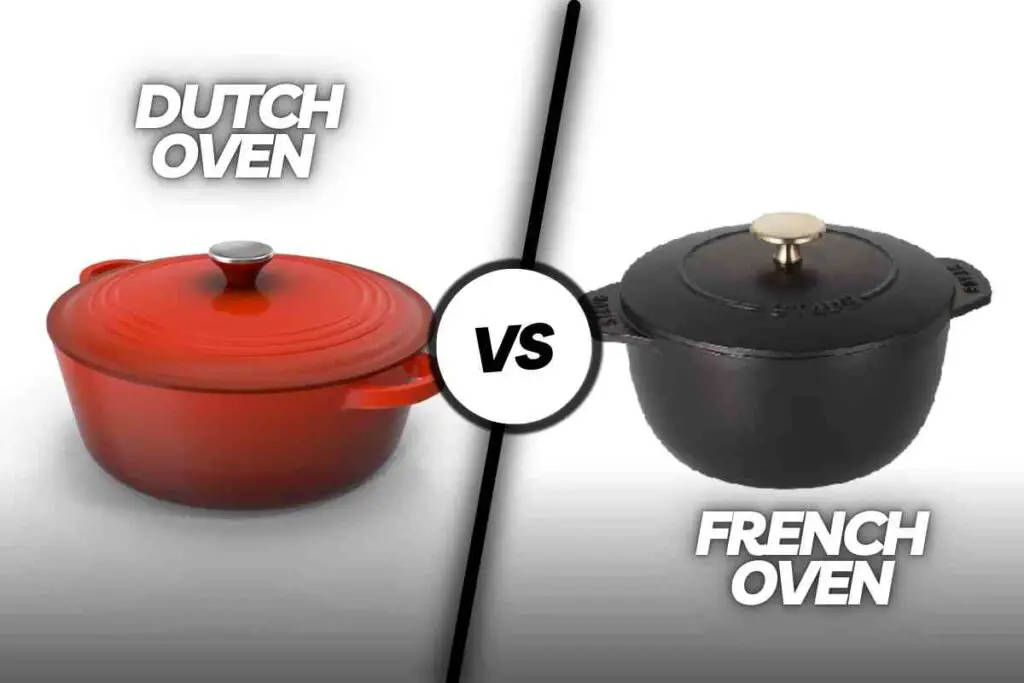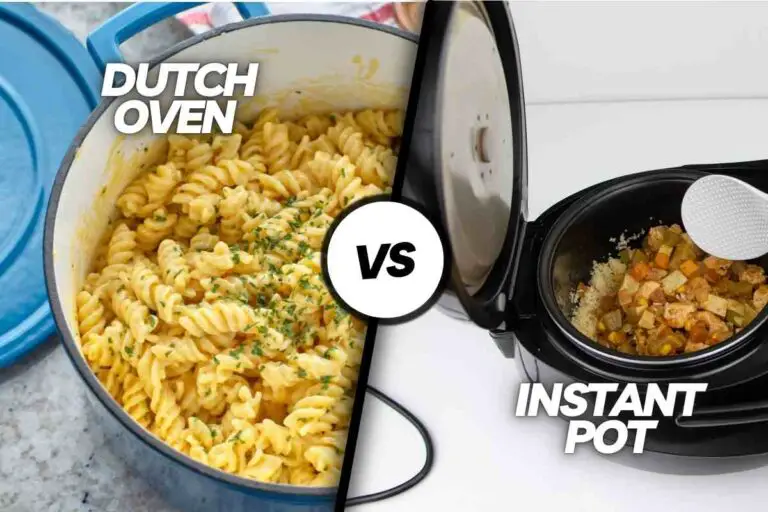7 Key Differences: French Oven Vs Dutch Oven
The main difference between a French Oven and a Dutch Oven is in their construction and design. A Dutch Oven is typically round and made solely from cast iron, lacking any enamel coating. On the other hand, a French Oven can be either round or oval and is made from thinner gauge cast iron.
Dutch oven is often associated with outdoor cooking and is known for its durability and heat retention. While, French Oven features a porcelain enamel coating both inside and out, making it more visually appealing and less likely to damage your cooktop.
While it shares similarities with a Dutch Oven, the enamel coating sets it apart, offering additional protection and aesthetic appeal.
7 Key Differences: French Oven Vs Dutch Oven
| Characteristic | French Oven | Dutch Oven |
|---|---|---|
| Material | Made from thinner gauge cast iron | Made from cast iron only |
| Coating | Enamel coating inside and out | No enamel coating |
| Shape | Can be round or oval | Typically round |
| Appearance | Visually appealing, often colorful | Rugged, plain cast iron look |
| Heat Retention | Good heat retention, but slightly less than Dutch Oven | Excellent heat retention |
| Versatility | Versatile for various cooking methods | Versatile for various cooking methods |
| Durability | Prone to chipping or cracking enamel | Highly durable without enamel |

A Brief History
The term “French oven” is often used interchangeably with “Dutch oven,” but the origin of the Dutch oven is actually Dutch, not French.
The Dutch oven was created in the Netherlands in the 17th century and became popular in France in the 18th century.
The French began calling it a “Dutch oven” in reference to its Dutch origin, but over time the name evolved to “French oven.”
Today, both terms are used to describe a heavy, cast iron pot with a tight-fitting lid that is suitable for both stovetop and oven cooking.
Difference Between French Oven Vs Dutch Oven
So, what’s the difference between a dutch oven and a french oven? A Dutch oven and a French oven are essentially the same things, with a few minor differences.
A Dutch oven is a heavy, cast iron pot with a lid that can be used for a variety of cooking tasks, such as braising, baking, roasting, and stewing.
A French oven, on the other hand, is a similar type of pot but is typically made of enameled cast iron and is marketed as a premium version of a Dutch oven.
The enamel finish provides a non-reactive surface and comes in a range of colors, while a Dutch oven is typically only available in black.
Both are versatile and long-lasting, but the French oven is typically more expensive.
What Are the Best Brands?
The following are the three best brands for dutch and french ovens:
1. Le Creuset
Le Creuset Dutch ovens are renowned for their superior heat distribution, retention, and durability, making them the perfect choice for slow-cooking dishes to perfection.

Try this Le Creuset French Oven.
I recently purchased the Le Creuset Enameled Cast Iron Signature Round Dutch Oven, 4.5 Quart, and I am extremely impressed with this product. The enameled cast iron delivers superior heat distribution and retention, making it ideal for slow-cooking dishes such as stews, soups, and braises.

Try this Le Creuset Enameled Deep Round Oven.
I love that it requires no seasoning and is ready to use straight out of the box. The easy-to-clean enamel is durable and resists dulling, staining, chipping, and cracking.

Try this Le Creuset Dutch Oven.
The light-colored smooth interior enamel makes it easy to monitor the cooking progress, and the tight-fitting lid is specially designed to circulate steam and return moisture back to the food, ensuring that the dish remains moist and flavorful.
2. Lodge
The Lodge Dutch oven and the French oven are similar to one another. Both are cast iron and feature a seasoned layer.
The French oven is always made with enameled cast iron and carries a French label. Popular brands of French ovens include Le Creuset and Staub.

3. Chasseur
Chasseur Dutch Ovens are premium quality cookware known for their durability, versatility, and excellent heat retention for flavorful and succulent cooking.
I recently got a chance to use the Chasseur Cast Iron Dutch Oven. Its even heat distribution makes it the perfect choice for cooking stews and heavy cassoulets, as it allows for tender meat every time.

The oven is also very easy to clean and durable, making it a long-lasting addition to my kitchen. I was pleased to find that it is compatible with standard stovetops, induction ranges, and conventional ovens, making it versatile for all of my cooking needs.
The black enamel sealing on the edges and the added color enamel make the oven not only functional but also visually appealing. The included matching lid helps to retain heat and moisture while cooking, making this a complete kitchen solution.
What Is a French Oven Used for
A French oven is a heavy, round, lidded cooking pot made of cast iron or enameled cast iron. It is versatile and can be used for a variety of cooking tasks, including:
- Braising: The heavy lid and even heat distribution make the French oven ideal for braising meat and vegetables, resulting in tender, flavorful dishes.
- Baking: The oven can be used for baking bread and other baked goods, as well as for roasting meats and vegetables.
- Stewing: The French oven is perfect for slow-cooking stews and soups, as it retains heat and moisture, ensuring a flavorful and evenly cooked meal.
- Frying: The heavy construction of the French oven makes it suitable for deep-frying, as it retains heat well and provides a consistent cooking temperature.
- Sautéing: The oven can also be used for sautéing, as the heavy construction helps to distribute heat evenly and prevent food from sticking.






